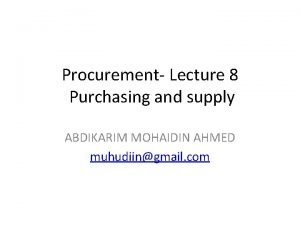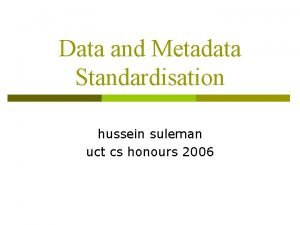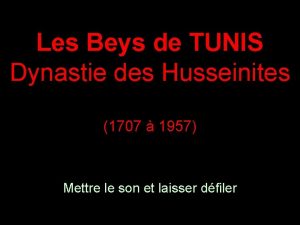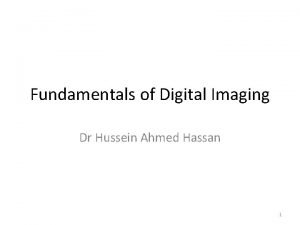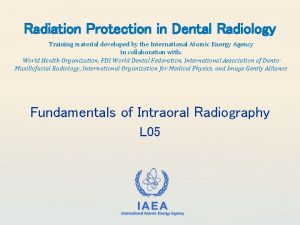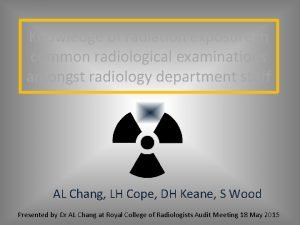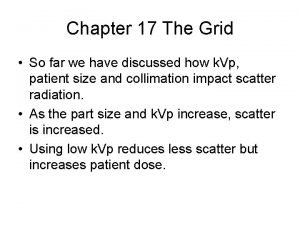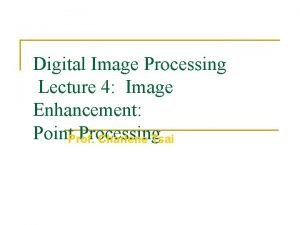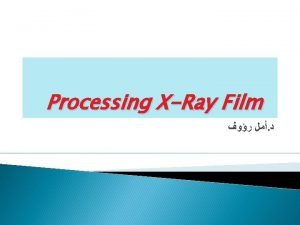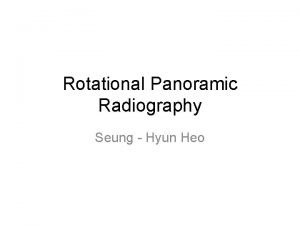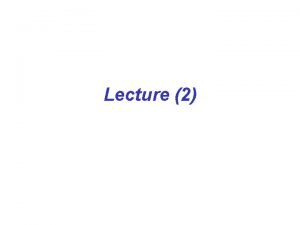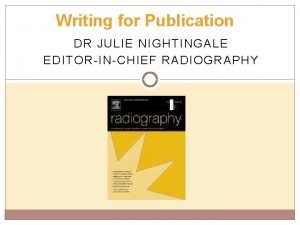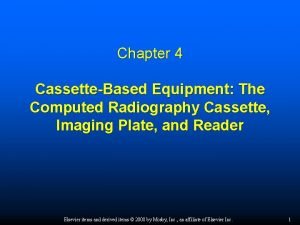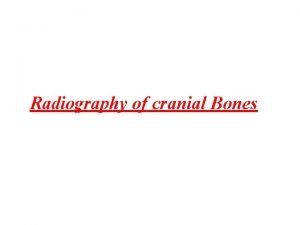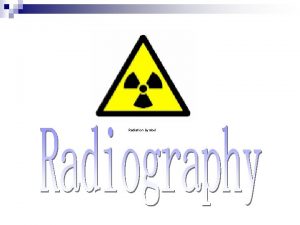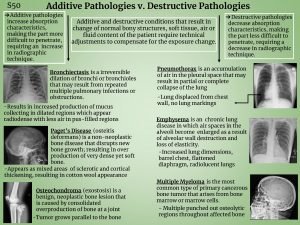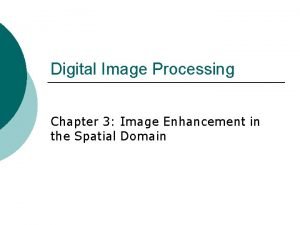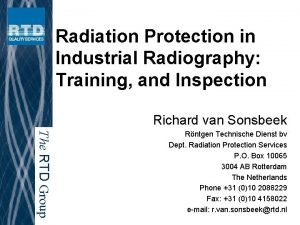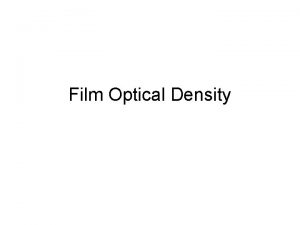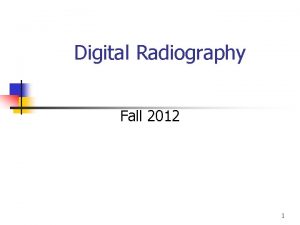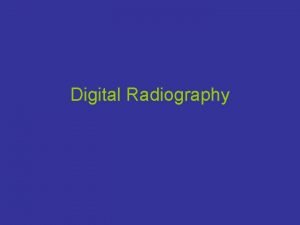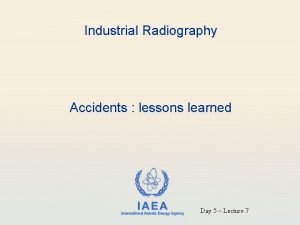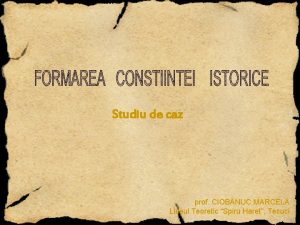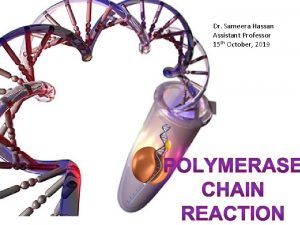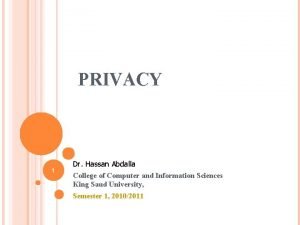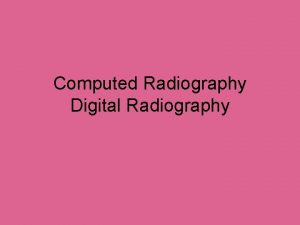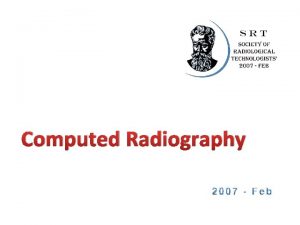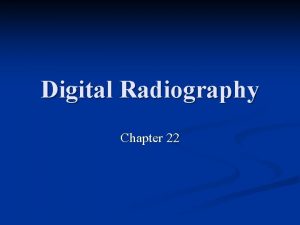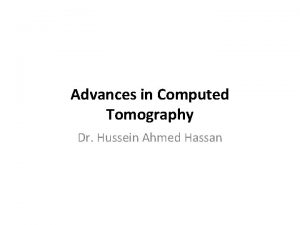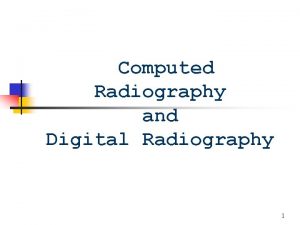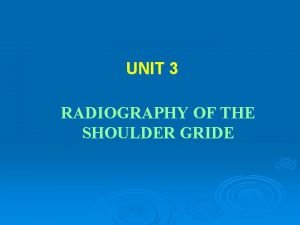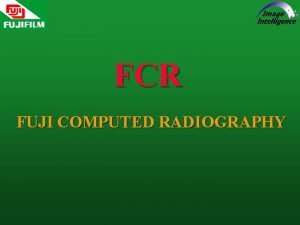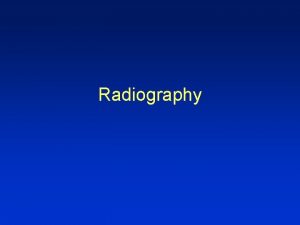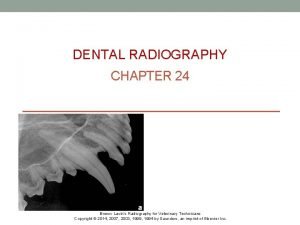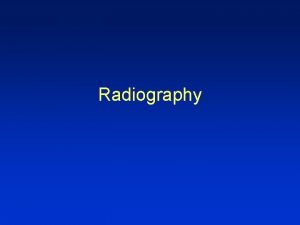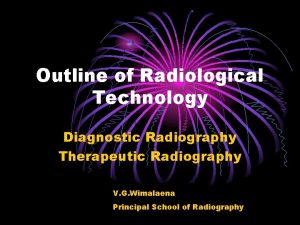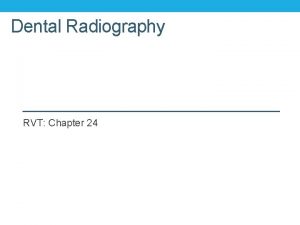DIGITAL RADIOGRAPHY Dr Hussein Ahmed Hassan t i


































































- Slides: 66

DIGITAL RADIOGRAPHY Dr Hussein Ahmed Hassan

t i v e s D e f i n e t h e t e r m d i

t i v e s C o m p a r e a n d c o n t r a

e r m s Computed radiography DICOM (digital imaging and communications in medicine) Digital imaging Digital radiography Direct capture DR Indirect capture DR Teleradiology

R a d i o g r a p h y M e t h o d i s f i l m b a s

CI o mn av ge en t i Ao cn a ql u i. X sr Drying Xray developer water fixer water

I m a g i n g D i g i t a l i m a g i n g i s a


n t � o f D i g i t a l I m CT coupled imaging devices and the computer. Early CT scanners required hours to produce a single slice. Reconstruction images took several days to produce. First CT scanners imaged the head only.

n M t a �g o n e f t i D c i g i t a l r e s o n a n c e I m i

n F t l �u o o f r o s D c i o g p i i t c a l i m a I g m e

C o n c e p t b e g a n w i t h Digital Radiography Development

E a r l y p r o c e s s i n v o Digital Radiography Development

CCD = chargecoupled device, FPD = flat-panel detector, TFT = thin-film transistor. Chart provides a systematic overview of various types of digital detectors.

a d i o g r a p h y Uses storage phosphor plates Uses existing equipment Requires special cassettes Requires a special cassette reader Uses a computer workstation and viewing station and a printer

a d i o g r a p h y Storage phosphor plates are similar to intensifying screens. Imaging plate stores x-ray energy for an extended time. Process was first introduced in the United States by Fuji Medical Systems of Japan in 1983. First system used a phosphor storage plate, a reader, and a laser printer.

a d i o g r a p h y M e t h o d w a s s l o w t o

Image Acquisition CR X-ray Tube Latent image Readout Photomultipl ier Erasure ADC IP Ready Fluorescent Workstation

v On photostimulable phosphor (PSP) plates, the phosphor layer is typically 0. 1 to 0. 3 mm thick.

Energy storage v After the initial exposure by typically, X-ray excited electrons enter the conduction band of the crystal and become trapped in the bromine ion empty lattice of the crystal. v These electrons resulting in a metastable state that is higher in energy than the original condition.

Energy release v The release of stored energy within a phosphor by stimulation with visible light, to produce a luminescent signal

v Afterwards, the plates can be "erased, " by exposing the plate to room-intensity white light. Thereby, the plate can be used over and over again. v Imaging plates can theoretically be re-used thousands of times if they are handled carefully and under certain radiation exposure conditions.

Readout of a PSP plate


a d i o g r a p h y C a s s e t t e l e s s s y s t e

Image Acquisition DR 1. X-ray scintillator bonded to readout ray, thin-film transistor (TFT) X-ray Tube Workstati on Detectors

a d i o g r a p h y 1. 2. Two types of digital radiography Indirect capture DR Direct conersion

a d i o g r a p h y I n d i r e c t c a p t u r e





v A photoconductor that converts x-ray photons into electrical charges by setting electrons free v Typical photoconductor materials include amorphous selenium, lead iodide, lead oxide, thallium bromide, and gadolinium compounds


DEL= Dector ELment DEL = charge collecting detector element


Fill Factor The percentage of the pixel face that contains the x-ray detector. Fill factor is approximately 80%

The ability of DEL to produce highb spatial resultion radiograph is desgined by the % of active area within the DLE which is known as Fill Factor.

There dirct relation % of Fill factor and spatial resolution asfill factor increase spatial resoltution increase


A CCD is a light-sensitive sensor for recording images that consists of an integrated circuit containing an array of linked or coupled capacitors.

Charged Couple Device x x in Charged Couple Device there is no photodiode or TFT

Charged Couple Device is connected to Senor through lenses or fiber optics

Optical lenses are needed to reduce the area of the projected light to fit the CCD array

Electrical signal is sent to computer for processing. • Image is viewed on computer screen. •



a d i o g r a p h y D i r e c t c o n e r s i o n n

The semiconuctor is prepared by applyig high voltge electrical charge nono secod before expoure

The interaction between electrical and x-rays cause the semiconductor to release electrical charge

• Electrical signal is sent to computer for processing Image is viewed on computer screen.


a d i o g r a p h y D R u s e d C C D t e c h n o

F o r c o n v e n t i o n a l x Comparison of Film to CR and DR

Comparison of Film to CR and DR Latent image formation is different in CR and DR. Conventional film/screen Film is placed inside of a cassette that contains an intensifying screen. • X-rays strike the intensifying screen, and light is produced. • The light and x-ray photons interact with the silver halide grains in the film emulsion. •

• A n e l e c t r o n i s e j e c t e d f r Comparison of Film to CR and DR

Comparison of Film to CR and DR CR • • • A storage phosphor plate is placed inside of CR cassette. Most storage phosphor plates are made of a barium fluorohalide. When x-rays strike the photosensitive phosphor, some light is given off. Some of the photon energy is deposited within the phosphor particles to create the latent image. The phosphor plate is then fed through the CR reader.

C R , Comparison of Film to CR and DR c o n t i n u e d • F o c u s e

D R • N o c a s s e t t e s a r e Comparison of Film to CR and DR

D R , Comparison of Film to CR and DR c o n t i n u e d • I n d i r e

o c e s s i n g C o n v e n t i o n a l r a d i o g r


C �o o n r v e D n t y i n o a n m a i l c r a R d a i n o

� o r D y n a m i c R a n g CR and DR • • Contain a detector that can respond in a linear manner. Exposure latitude is wide, allowing the single detector to be sensitive to a wide range of exposures. Kilovoltage peak still influences subject contrast, but radiographic contrast is primarily controlled by an image processing look-up table. Milliampere-second setting has more control over image noise, whereas density is controlled by image-processing algorithms.

e n s i t i v i t y I t i s i m p o r t a n t t o 65

 Foreign object in eye
Foreign object in eye Ahmed muhudiin ahmed
Ahmed muhudiin ahmed Hussein suleman
Hussein suleman Nadya hussein
Nadya hussein Saddam hussein
Saddam hussein Mbbsch
Mbbsch Saddam hussein
Saddam hussein Laila hussein
Laila hussein Diyar hussein
Diyar hussein Hussein suleman
Hussein suleman Karen hussein
Karen hussein Chicken humour
Chicken humour Hussein suleman
Hussein suleman Dr hussein saad
Dr hussein saad Alex hoffer stanford
Alex hoffer stanford Hussein mahmood 1985
Hussein mahmood 1985 Reporaproblem
Reporaproblem Alma hussein 28
Alma hussein 28 Hussein ii bey
Hussein ii bey Subhanallahi rabbil alamin
Subhanallahi rabbil alamin Bassam hussein
Bassam hussein George hw bush apush
George hw bush apush Hussein suleman
Hussein suleman Ananda sabil hussein
Ananda sabil hussein Dr. hussein shaqra
Dr. hussein shaqra Dr rania hussein
Dr rania hussein Taha hussein challenges
Taha hussein challenges Audrey sedal mcgill
Audrey sedal mcgill Common causes of faulty radiographs
Common causes of faulty radiographs Urethrorhagia
Urethrorhagia Limitations of radiography
Limitations of radiography Oscillating grid radiography
Oscillating grid radiography Recorded detail in radiography
Recorded detail in radiography Mask mode radiography
Mask mode radiography Rni radiography
Rni radiography What are the two areas in dark room? *
What are the two areas in dark room? * Latent image formation in radiography
Latent image formation in radiography Focal trough in panoramic radiography
Focal trough in panoramic radiography Msp meaning in radiography
Msp meaning in radiography Buccal object rule
Buccal object rule Radiography
Radiography Gurney mott theory
Gurney mott theory X ray cassette construction
X ray cassette construction The objective of sharpening spatial filter is to
The objective of sharpening spatial filter is to Ombl radiography
Ombl radiography Radiography barricade distance
Radiography barricade distance Grid radius radiology
Grid radius radiology Radiographic errors in dentistry ppt
Radiographic errors in dentistry ppt Chapter 42 extraoral imaging
Chapter 42 extraoral imaging Types of occlusal radiograph
Types of occlusal radiograph Soot and whitewash radiography
Soot and whitewash radiography Is osteoporosis additive or destructive
Is osteoporosis additive or destructive Chapter 3 image
Chapter 3 image Industrial radiography training
Industrial radiography training Optical density in radiography
Optical density in radiography Filmless radiography
Filmless radiography Sulphonal casset
Sulphonal casset Industrial radiography accidents
Industrial radiography accidents Industrial radiography accidents
Industrial radiography accidents Radiography safety precautions
Radiography safety precautions Comparati baladele pasa hassan
Comparati baladele pasa hassan Khaled hosseini hassan
Khaled hosseini hassan Dr fatima sameera
Dr fatima sameera Ayaz ul hassan
Ayaz ul hassan Kite runner chapter 25
Kite runner chapter 25 Dr hassan abdalla
Dr hassan abdalla Hassan tout
Hassan tout

